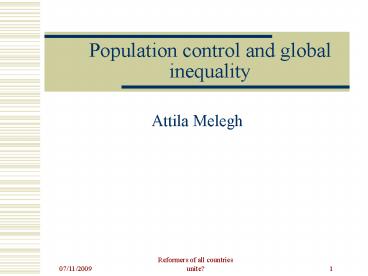Population control and global inequality - PowerPoint PPT Presentation
1 / 18
Title:
Population control and global inequality
Description:
Self-positioning of the 'reform'-internationalisms within, and in relation to, ... Communists want to adjust the economy to the population (Name is not given cited ... – PowerPoint PPT presentation
Number of Views:32
Avg rating:3.0/5.0
Title: Population control and global inequality
1
Population control and global inequality
- Attila Melegh
2
Aim of the seminar
- Self-positioning of the reform-internationalisms
within, and in relation to, global inequality
and global power relations.
3
The space system of global inequalities
- Global colonial-capitalism since the 18th century
and its cycles. - Global economic hierarchy.
- Global imaginary civilisation, coloniality
4
Malthus and the liberal humanitarian utopia
- Definition of population control.
- How hierarchies are set up?
- Positive and negative checks.
- Biopolitical balances.
- Measuring societies.
5
Malthus and global inequalities
- Subordination of agrarian capitalism.
- Colonialism.
- If we do not then consider this apathy of the
Americans as a natural defect in their bodily
frame, but merely as a general coldness, and an
infrequency of the calls of the sexual appetite,
we shall not be inclined to give much weight to
it as affecting the number of children to a
marriage but shall be disposed to look for the
cause of this unfruitfulness in the condition and
customs of the women in a savage state.
6
Development of the internalization of
Malthusianism
- Internal development of the thought.
- History of the global system.
- Internal positioning and interplay. This latter
is crucial and not researched.
7
Colonial epoch
- No international movement, but still exported.
- British empire practiced inside and outside.
- Colonial intervention and non-intervention.
- Extreme biopolitical racism and liberalism.
8
National population movements. The era
- Scientific progress.
- Demographic changes.
- Uprooted populations.
9
National reform movements internal development
- Neo-Malthusianism and the alliance with
feminists, anti-immigration campaigners. - The rise of national and inter-national
organizations and co-operation. - Global position in the system of inequalities.
10
National reform movements varying reactions
- The spread of neo-Malthusianism and
discrepancies. The need to become populuos. - France and Italy.The combination of quality and
quantity.
11
National reform movements varying reactions
- Germany Differentiation according to classes and
races.. - Latin-America anti-local and anti-immigrant
(Argentina). - Latin-America and Eastern Europe pro-local,
anti-alien. (Mexico, Hungary).
12
The rise of the international reform movement
- Shift in hegemony, decolonization, the rise of
communism. - Overpopulation globally Demographic transition
and modernization theory.
13
The rise of the international reform movement
- Colonial systems, formal and otherwise, in which
the mother country endeavors to retain the colony
primarily as a source of raw materials and as a
market for manufactured goods stimulate
population growth without reducing the
potentialities for future population growth. The
influence of the United States should be exerted
against the reestablishment of such systems where
they have broken down and toward their alteration
where they exist. The upheavals of the war, and
the strong stand already taken on freedom of
access to raw materials and markets offer an
opportunity in that direction. (Seeley G. Mudd
Manuscript Library, Princeton Box no. FW.1).
14
The rise of the international reform movement
- Improvement in this situation is slow to develop,
because it has so happened that the advanced
nations have tended to transfer to dependent
peoples that part of their culture, which reduces
mortality, but they have not disseminated the
complementary cultural developments, which tend
to bring about a rational control of fertility. - The dissemination of birth-control information,
while of undoubted use in reducing population
growth, would not meet the needs of these
colonial populations. Therefore, the only lasting
solution is one, which would bring about a
reduction of growth potential. - Continuing, Mr. Notestein pointed out that in all
probability a reduction of growth potential can
only be brought about by education, urbanization,
and a gradual increase in the standard of living
(Seeley G. Mudd Manuscript Library, Princeton Box
no. FW.1).
15
The full development of this movement
- The shift of anti-communism.
- The need to intervene.
- USA leading and international league.
- Maintaining the combination in new circumstances.
- International organizations International
Planned Parenthood Federation. - Internal blows.
16
Varying reactions
- Cruelly, you Western demographers intend to
adjust the population to the economy, while we
Communists want to adjust the economy to the
population (Name is not given cited by Petersen,
1988, 93). - India population emergency plans.
- China the victory of science.
- Control of quality in Eastern Europe the rise of
a new Nazism. - Latin America suspicion and radicalism
17
Varying reactions
- Wealth of the continent is not yet utilized.
- There is a low population density.
- The aim is to reduce social pressure in this way
and through massive social changes. - The US wants to reduce foreign aid with this.
- The concern in the US for population control
(wanted fertility) is lower. - The US wants to reduce demand for resources.
18
Loosing the grip
- Reintegrating development and population.
- Not anymore a reform idea.
- New ways of protecting piriveleged lives.































